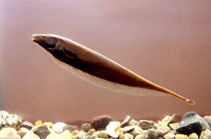| Family: |
Apteronotidae (Ghost knifefishes), subfamily: Apteronotinae |
| Max. size: |
26.9 cm TL (male/unsexed) |
| Environment: |
benthopelagic; freshwater |
| Distribution: |
South America: the Guianas, Brazil and Peru; rivers of Colombia and Venezuela, including the Catatumbo River. |
| Diagnosis: |
Dorsal fin reduced to a dorsal filament; |
| Biology: |
Prefers fast flowing rivers (Ref. 26543). Forms loosely associated groups in rocky habitats or river banks (Ref. 10605). Nocturnal (Ref. 26543). Each individual fish possesses a unique spatiotemporal pattern of electric organ discharge (EOD) potentials distributed over the body surface (Ref. 10595). Chirps and EOD frequency modulations are important elements of courtship behavior and are sensitive to testosterone levels (Ref. 10011, 10883). Seems to reach sexual maturity at 1 year of age, based on breeding experiments (Ref. 10011). Tuberous electro receptors are differentiated and functional in larvae at day 9; electric organ and electro receptors both present in the larvae at the time of first exogenous feeding (Ref. 10605). |
| IUCN Red List Status: |
Endangered (EN); Date assessed: 12 December 2022 (B1ab(iii)+2ab(iii)) Ref. (130435)
|
| Threat to humans: |
harmless |
Source and more info: www.fishbase.org. For personal, classroom, and other internal use only. Not for publication.

